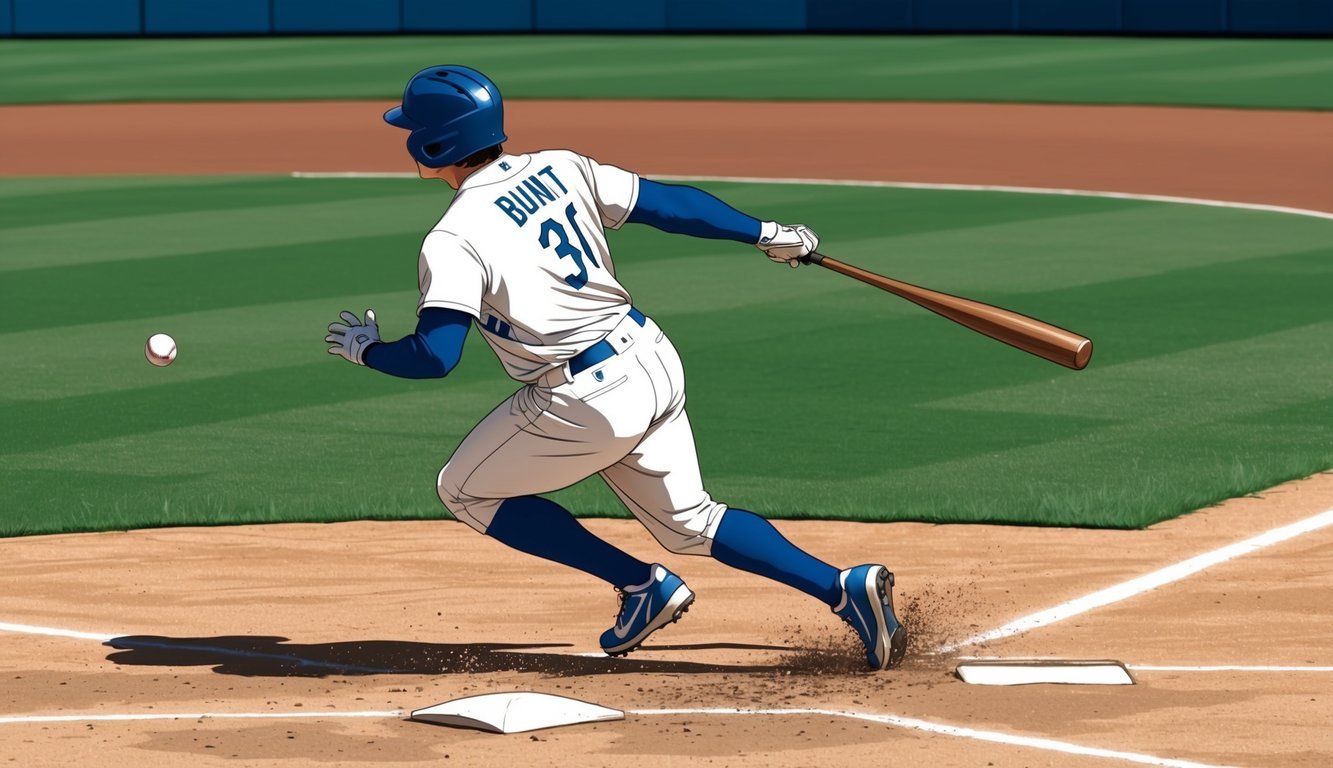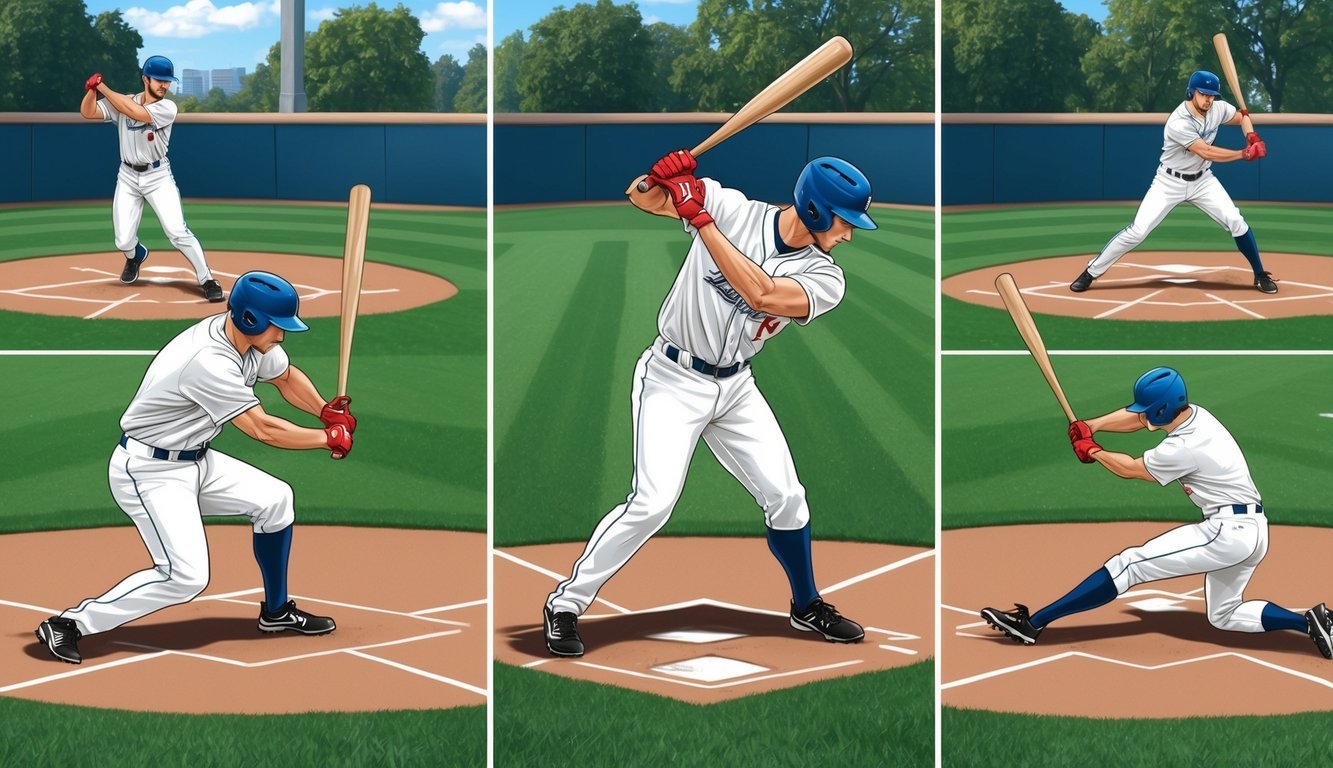Bunting is a crucial skill in baseball that can change the course of a game.
It involves deliberately tapping the ball into play rather than swinging for a powerful hit. Three main types of bunts in baseball are sacrifice bunts, drag bunts, and squeeze bunts.
Mastering these different bunt techniques gives players a strategic advantage on the field.
Each type serves a specific purpose, from advancing runners to catching the defense off-guard.
Understanding when and how to execute these bunts can make a significant difference in a team’s offensive strategy.
Bunting requires precision, timing, and a good understanding of the game situation.
Players who excel at bunting become valuable assets to their teams, often able to turn the tide of a close match with a well-placed bunt.
Let’s explore the various types of bunts and how they’re used in America’s favorite pastime.
The Basics of Bunting
Bunting is a crucial skill in baseball that requires precision and strategy.
It involves deliberately tapping the ball into play rather than swinging for a full hit.
Defining the Bunt
A bunt is a batting technique where the batter holds the bat out and lets the ball make contact with it, rather than swinging.
The goal is to tap the ball softly into play, usually in front of home plate.
Bunts are often used to advance runners on base or to surprise the defense.
Bunts can be classified as sacrifice bunts, where the batter aims to advance runners while accepting being put out, or as bunt hits, where the batter attempts to reach base safely.
The official scorer determines if a play is scored as a bunt based on the batter’s intent and the outcome.
Bunting Technique and Stance
Proper bunting technique starts with the batter’s stance.
As the pitcher begins their motion, the batter pivots to face the pitcher, keeping their feet shoulder-width apart.
They crouch slightly, bending at the knees.
The bat is held at chest level, angled slightly downward.
The top hand slides up the bat, gripping it near the label.
The bottom hand controls the bat’s movement.
To bunt effectively, the batter must:
- Watch the ball closely
- Keep the bat still until contact
- Use the bat to guide the ball, not hit it forcefully
- Aim for specific areas of the field based on the desired outcome
Practice is key to mastering this skill and becoming a valuable asset to the team’s offensive strategy.
Types of Bunts in Baseball
Bunting is a strategic offensive technique in baseball where batters deliberately tap the ball into play.
Different types of bunts serve various purposes, from advancing runners to catching the defense off-guard.
The Sacrifice Bunt
The sacrifice bunt is a selfless play designed to advance baserunners.
A batter executes this bunt by squaring up early and placing the ball in fair territory, usually toward first or third base.
The goal is to move runners into scoring position, even at the cost of the batter being thrown out.
Proper technique involves gripping the bat loosely and angling it downward.
Batters aim to deaden the ball’s momentum, making it difficult for fielders to turn a double play.
This strategy is often employed in close games or when run production is crucial.
Sacrifice bunts are common in late-game situations or with pitchers batting in National League games.
Bunting for a Base Hit
Bunting for a base hit aims to catch the defense unprepared and reach first base safely.
Two primary types are the drag bunt and push bunt.
The drag bunt involves left-handed batters starting their running motion as they bunt, gaining a head start toward first base.
They angle the bat to direct the ball past the pitcher, ideally between the mound and first base.
Push bunts are executed by right-handed batters who “push” the ball toward the right side of the infield.
This technique requires precise bat control to place the ball in the gap between first and second base.
Both methods rely on surprise and speed to be effective.
The Squeeze Play
The squeeze play is an aggressive tactic to score a runner from third base.
There are two variations: the suicide squeeze and the safety squeeze.
In a suicide squeeze, the runner on third base starts for home as the pitcher begins their delivery.
The batter must make contact to protect the runner.
This high-risk, high-reward play can result in an easy run if executed properly but may lead to an out if the bunt is missed.
The safety squeeze is less risky.
The runner waits to see if the bunt is successful before committing to home plate.
This allows for better judgment but gives the defense more time to react.
Squeeze plays require excellent timing and communication between the batter and baserunner.
Executing a Successful Bunt

Executing a successful bunt requires precision, timing, and practice.
The batter must master proper technique while staying alert to the positioning of fielders and the element of surprise.
Positioning and Grip
The batter’s stance is crucial for a successful bunt.
They should turn their body towards the pitcher, keeping their feet shoulder-width apart.
The front foot should point towards third base for right-handed batters, or first base for lefties.
Grip is equally important.
The batter should slide their top hand up the bat, placing it just below the label.
The bottom hand should grip the bat loosely, allowing for better control.
To square up, the batter pivots on their back foot, turning their hips and shoulders towards the pitcher.
The bat should be held at a 45-degree angle, with the barrel slightly higher than the hands.
The Element of Surprise
Surprise is a key factor in successful bunting.
Batters often wait until the last moment to show bunt, keeping fielders guessing.
This delayed action can catch the defense off-guard.
For drag bunts, the batter starts in their normal stance and only reveals their intent as the pitch approaches.
They then pivot and run simultaneously, dragging the bat to make contact.
Skilled bunters can also use eye movements and body language to deceive fielders.
By appearing to prepare for a full swing, they can keep the defense from creeping in too early.
Fielder’s Responses
Understanding how fielders react to bunts is crucial.
Third and first basemen typically charge in when a bunt is shown, while the pitcher and catcher move to cover the bases.
Batters should aim for areas that are hardest for fielders to reach.
Bunting towards third base can be effective, as the third baseman has the longest throw to first.
For sacrifice bunts, placing the ball between the pitcher and first baseman can be ideal.
This forces the pitcher to field the ball, giving runners more time to advance.
Smart bunters also consider the speed and defensive skills of individual fielders when deciding where to place the ball.
Strategic Use of Bunts in Gameplay

Bunting serves as a versatile offensive tool in baseball, offering teams multiple ways to gain tactical advantages.
When executed effectively, bunts can shift momentum, apply pressure on the defense, and create scoring opportunities.
Advancing Runners
Bunting to advance runners is a classic strategy.
The sacrifice bunt moves baserunners into scoring position, trading an out for improved run-scoring chances.
Skilled bunters can place the ball precisely, forcing defenders to make difficult plays.
Drag bunts can catch infielders off-guard, allowing fast runners to reach base safely while advancing others.
This technique is particularly useful with runners on first or second base.
Push bunts toward the opposite field can be effective when executed by left-handed batters.
This strategy often catches the defense unprepared, increasing the chances of a successful play.
Late Innings and Scoring Position
In close games, bunting becomes crucial during late innings.
Teams may opt for a sacrifice bunt to move a runner into scoring position, setting up a potential game-winning hit.
The squeeze play, where a runner on third base breaks for home as the batter bunts, can be a high-risk, high-reward tactic.
It’s most effective when the element of surprise is maintained.
Bunting for a base hit in late innings can also spark rallies.
A well-placed bunt can put pressure on the defense and potentially lead to errors or additional scoring opportunities.
Reacting to Defensive Shifts
As defensive shifts become more common, bunting has emerged as a counter-strategy.
Batters can exploit open areas of the infield by bunting against the shift, often resulting in easy base hits.
Left-handed pull hitters frequently face extreme shifts.
A well-executed bunt down the third base line can neutralize this defensive alignment, forcing teams to reconsider their positioning.
Bunting against shifts can also have long-term strategic value.
If a batter consistently shows the ability to bunt for hits, defenses may be less likely to employ extreme shifts in future at-bats.
Common Bunting Mistakes and Tips

Mastering the art of bunting requires attention to detail and practice.
Avoiding common errors and implementing effective techniques can dramatically improve a player’s bunting skills.
Avoiding Foul Bunts
Foul bunts often result from poor bat angle or improper contact point.
To prevent this:
- Keep the bat at a slight upward angle
- Meet the ball in front of home plate
- Aim for the top half of the ball
Coaches emphasize keeping hands loose and letting the bat absorb the impact.
This control helps direct the ball fair.
Practice bunting different pitch types to improve adaptability.
Focus on reading the pitch early to adjust your stance and bat position accordingly.
Preventing Pop-Ups
Pop-ups are a bunter’s nemesis, often leading to easy outs.
To avoid them:
- Don’t “stab” at the ball
- Use a gentle pushing motion
- Keep the bat below the ball at contact
Coaches stress the importance of proper footwork.
A slight pivot can help position the body for better control.
Try drills that focus on soft hands and bat control.
Use a tee or soft toss to practice keeping the ball on the ground consistently.
Incorporating various drills can significantly improve your batting skills and enhance your overall performance at the plate.
By integrating 2 seam fastball grip techniques, you can better understand how to adjust your swing based on pitch types.
Mastering these methods will not only help you make solid contact but also develop a more precise control over where you place the ball in the field.
Practice for Precision
Dedicated practice helps improve precision in bunting.
Here are a few tips to help you practice better:
- Set up targets on the field
- Practice bunting to specific areas
- Work on both sacrifice and drag bunts
You can also use a pitching machine to practice against various speeds and movements.
This helps simulate game situations.
Coaches recommend daily bunting practice, even if just for 10-15 minutes.
Focus on technique rather than quantity of reps.
To add pressure and fun to practice sessions, try bunting competitions with teammates.
This can help replicate game-like tension.
